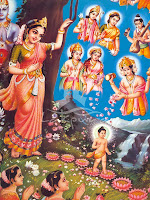"The Great Chronicle of The Buddhas" (Maha Buddhavamsa), Tipitakadhara Mingun Sayadaw, edited and translated by U Ko Lay and U Tin Lwi; further intensive editing Wisdom Quarterly
 |
| Setaketu (Santusita) in Tusita world |
The deva Setaketu, the future Buddha, enjoyed the supreme deva bliss in the [space] abode of Tusita for 4,000 years according to deva-time reckoning (which is equivalent to 576,000,000 years in the human world).
Then 1,000 human years before the end of his life-span in the Tusita world, divinities (brahmas) of the Pure Abodes (suddhavasa) proclaimed:
"Friends, 1,000 years from today there will appear in the human world an omniscient buddha!"
Because of this proclamation from the vault of the deva world, the uproar (buddha kolahala) announcing the appearance of a buddha, "An omniscient buddha will be appearing! An omniscient buddha will be appearing!" reverberated across the entire human world 1,000 years ahead of the event [Note 1].
The Devas' Request
On hearing the uproar announcing the advent of a buddha, the deva kings of the 10,000 world-systems -- such as the Four Great Sky Kings (near earth orbit rulers), Sakka, Suyama, Santusita (6th Heaven, Para-nimmita-vasavatti), Sunimmita, Vasavatti, and all Great-Brahmas congregated in a certain [galaxy or world-system] to hold a discussion on the Bodhisat (Bodhisattva) whose deva life-span had only seven days remaining, by human reckoning, and whose approaching end of life had become manifest through five predictive signs.
Then they all approached the deva Setaketu with their hands joined in adoration and made this request:
"O deva Bodhisat [Buddha-to-be], you have completely fulfilled the Ten Perfections, not with the desire to gain the bliss of Sakka [Michael or Thor, Lord of Lords (of Tavatimsa) and King of Kings (in the Realm of the Four Great Kings], of Mara (in Brahma's Retinue or 7th Heaven), of Brahma (in the Maha Brahma deva loka), or of a Universal Monarch (on Earth). You have fulfilled these perfections aspiring for all-knowing buddhahood in order to acquire for yourself freedom from the three worlds (spheres) as well as to liberate the multitudes of humans, devas ["shining ones"], and brahmas ["creative divinities," supremos].
"O deva Bodhisat, this is the most propitious time for you to become an omniscient awakened teacher! This is truly the right moment to become an omniscient awakened teacher! Therefore, take conception in the womb of the human world. And after attaining the supreme enlightenment of a teacher, liberate humans, devas, and brahmas from the round of suffering/rebirth (samsara) by teaching the Dharma of deathlessness: nirvana."
"O deva Bodhisat, this is the most propitious time for you to become an omniscient awakened teacher! This is truly the right moment to become an omniscient awakened teacher! Therefore, take conception in the womb of the human world. And after attaining the supreme enlightenment of a teacher, liberate humans, devas, and brahmas from the round of suffering/rebirth (samsara) by teaching the Dharma of deathlessness: nirvana."
The Five Great Investigations
 The deva Bodhisat Setaketu did not hastily consent to the supplication of the devas and brahmas who had come together from the 10,000 world-systems. Instead, in line with the tradition of previous bodhisattas, he made five great investigations:
The deva Bodhisat Setaketu did not hastily consent to the supplication of the devas and brahmas who had come together from the 10,000 world-systems. Instead, in line with the tradition of previous bodhisattas, he made five great investigations:
(1) Is it the appropriate time for the appearance of a buddha?
(2) Is there an appropriate world (dipa, island, continent, planet, light) for the appearance of a buddha?
(3) Is there an appropriate land for the appearance of a buddha?
(4) Is there an appropriate family into which to be reborn (in a final existence)?
(5) Is it the appropriate span of life of a bodhisatta's mother. More
NOTE: With reference to the name of the Buddha-to-be as a deva, it was Santusita according to the chapter on Ratanasankama, Buddhavamsa which in Pali reads: Yada'ham tusite kaye santusito nama'ham tada. Also in the commentary to the Buddhavamsa and Jinalankara Tika the same name is mentioned. But in the exposition
of the Pubbenivasa-katha, Veranja-kanda of the Parajika commentary, and
in the exposition of the Bhayabherava Sutra of the Mulapanasa commentary, his name is given as Setaketu ["White Banner"]. Moreover, successive
authors of Burmese chronicles or Buddhavamsas such as the Tathagata-Udana Dipani,
Malalankara Vatthu, Jinatthapakasani, etc., give Setaketu as the name of
the deva. Therefore, it has been explained by various teachers that
Santusita was a common name derived from Tusita -- the name of the
celestial abode (space world) -- whereas Setaketu was the proper name that specifically
refers to the deva who would become Prince Siddhartha the Buddha Gautama.



















































































































































































































































No comments:
Post a Comment